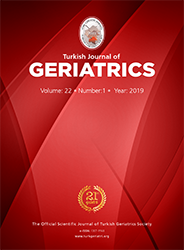2Bolu Abant ƒ∞zzet Baysal State Hospital, Department of Emergency Medicine, Bolu, Turkey DOI : 10.31086/tjgeri.2019150569 Introduction: A potentially inappropriate medication is defined as a drug that has higher adverse effects when compared with the clinical benefit, although a safer or more efficient alternative treatment exists given the same situation. This cross-sectional study aimed to assess the presence of polypharmacy (use of five or more drugs) in older patients aged ≥65 years.
Materials and Method: Geriatric patients presenting to the emergency department between January and March 2018 who had been prescribed five or more drugs were evaluated with a questionnaire for potentially inappropriate medication and polypharmacy. The questionnaire comprised demographic data, chronic diseases affecting elderly patients, and chronic drugs used according to the Beers criteria (2015 version) for elderly adults.
Results: The study cohort consisted of 144 patients (56 males, 88 females). The mean age of participants was 77.23±7.94 years. The most common chronic diseases were hypertension (22.5%), coronary artery disease (15.1%), and diabetes (10.7%). The three most commonly prescribed drugs were aspirin (10.8%), an angiotensin receptor blocker + thiazide (9.8%), and beta blockers (9.8%). The average number of medications used was 5.22±2.56. Polypharmacy was found in 80 patients (55.6%) whereas potentially inappropriate medication use was determined in 78 (54.2%) patients.
Conclusions: Both polypharmacy and potentially inappropriate medication use were found to have a high frequency in our study group. We found the use of potentially inappropriate medication to be significantly higher in patients with polypharmacy. The most used potentially inappropriate medications were proton pump inhibitors and non-steroidal anti-inflammatory drugs.
Keywords : Polypharmacy; Geriatrics; Potentially inappropriate medication
